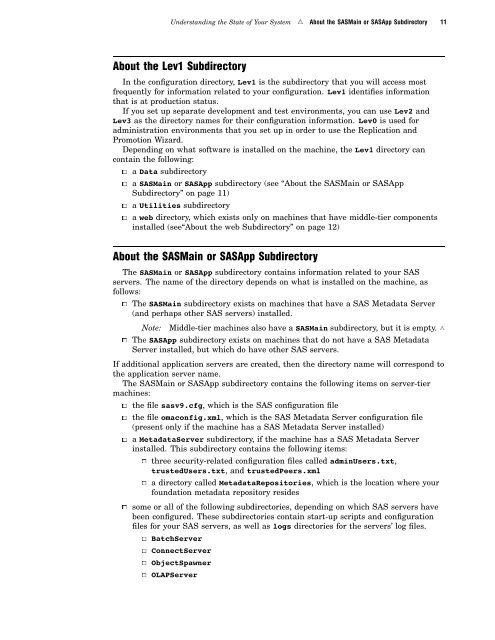SAS 9.1.3 Intelligence Platform: System Administration Guide
SAS 9.1.3 Intelligence Platform: System Administration Guide
SAS 9.1.3 Intelligence Platform: System Administration Guide
You also want an ePaper? Increase the reach of your titles
YUMPU automatically turns print PDFs into web optimized ePapers that Google loves.
Understanding the State of Your <strong>System</strong> R About the <strong>SAS</strong>Main or <strong>SAS</strong>App Subdirectory 11<br />
About the Lev1 Subdirectory<br />
In the configuration directory, Lev1 is the subdirectory that you will access most<br />
frequently for information related to your configuration. Lev1 identifies information<br />
that is at production status.<br />
If you set up separate development and test environments, you can use Lev2 and<br />
Lev3 as the directory names for their configuration information. Lev0 is used for<br />
administration environments that you set up in order to use the Replication and<br />
Promotion Wizard.<br />
Depending on what software is installed on the machine, the Lev1 directory can<br />
contain the following:<br />
3 a Data subdirectory<br />
3 a <strong>SAS</strong>Main or <strong>SAS</strong>App subdirectory (see “About the <strong>SAS</strong>Main or <strong>SAS</strong>App<br />
Subdirectory” on page 11)<br />
3 a Utilities subdirectory<br />
3 a web directory, which exists only on machines that have middle-tier components<br />
installed (see“About the web Subdirectory” on page 12)<br />
About the <strong>SAS</strong>Main or <strong>SAS</strong>App Subdirectory<br />
The <strong>SAS</strong>Main or <strong>SAS</strong>App subdirectory contains information related to your <strong>SAS</strong><br />
servers. The name of the directory depends on what is installed on the machine, as<br />
follows:<br />
3 The <strong>SAS</strong>Main subdirectory exists on machines that have a <strong>SAS</strong> Metadata Server<br />
(and perhaps other <strong>SAS</strong> servers) installed.<br />
Note: Middle-tier machines also have a <strong>SAS</strong>Main subdirectory, but it is empty. R<br />
3 The <strong>SAS</strong>App subdirectory exists on machines that do not have a <strong>SAS</strong> Metadata<br />
Server installed, but which do have other <strong>SAS</strong> servers.<br />
If additional application servers are created, then the directory name will correspond to<br />
the application server name.<br />
The <strong>SAS</strong>Main or <strong>SAS</strong>App subdirectory contains the following items on server-tier<br />
machines:<br />
3 the file sasv9.cfg, which is the <strong>SAS</strong> configuration file<br />
3 the file omaconfig.xml, which is the <strong>SAS</strong> Metadata Server configuration file<br />
(present only if the machine has a <strong>SAS</strong> Metadata Server installed)<br />
3 a MetadataServer subdirectory, if the machine has a <strong>SAS</strong> Metadata Server<br />
installed. This subdirectory contains the following items:<br />
3 three security-related configuration files called adminUsers.txt,<br />
trustedUsers.txt, and trustedPeers.xml<br />
3 a directory called MetadataRepositories, which is the location where your<br />
foundation metadata repository resides<br />
3 some or all of the following subdirectories, depending on which <strong>SAS</strong> servers have<br />
been configured. These subdirectories contain start-up scripts and configuration<br />
files for your <strong>SAS</strong> servers, as well as logs directories for the servers’ log files.<br />
3 BatchServer<br />
3 ConnectServer<br />
3 ObjectSpawner<br />
3 OLAPServer
















